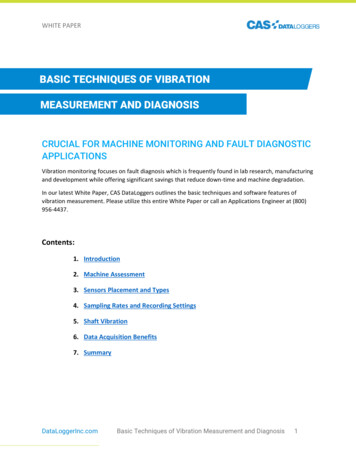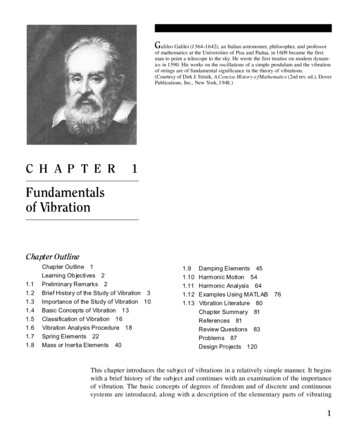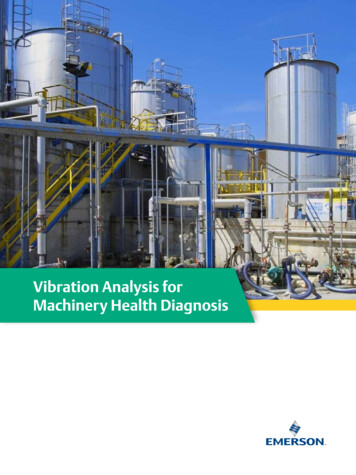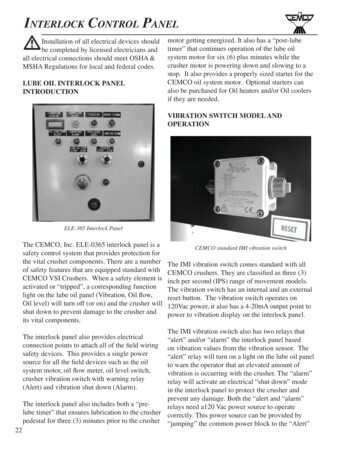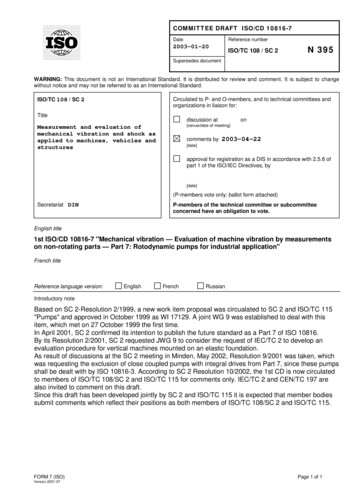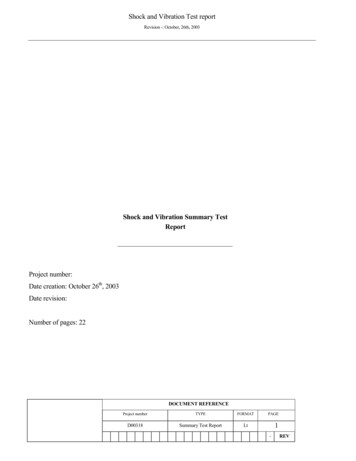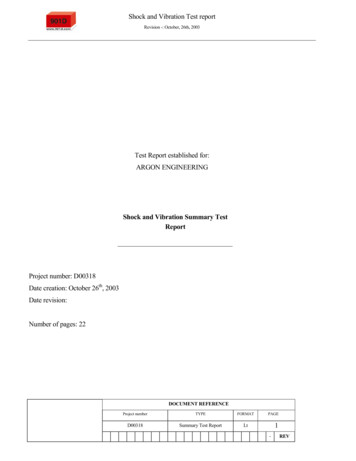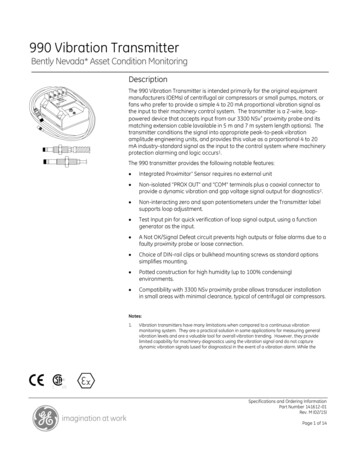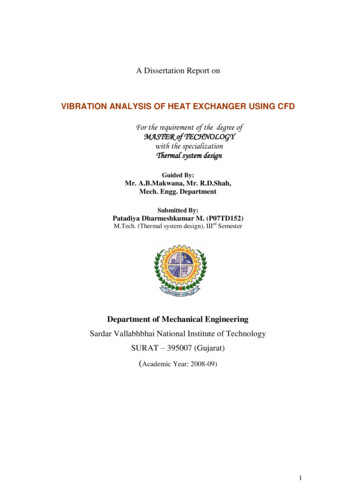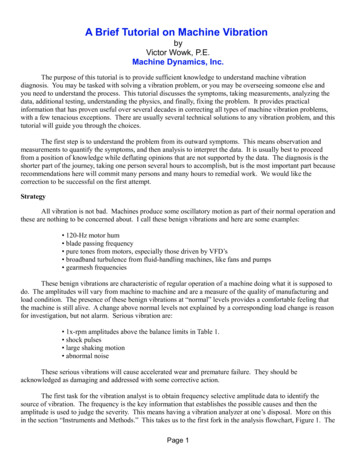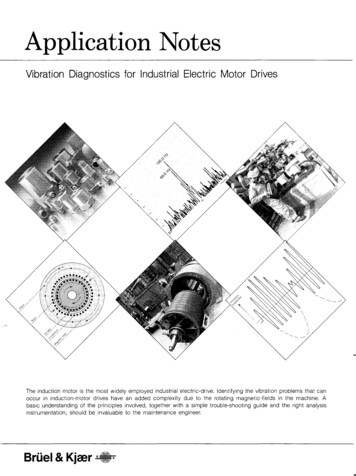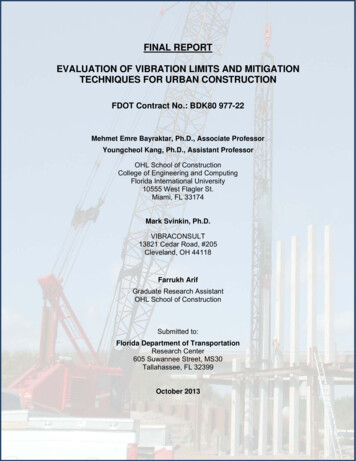
Transcription
FINAL REPORTEVALUATION OF VIBRATION LIMITS AND MITIGATIONTECHNIQUES FOR URBAN CONSTRUCTIONFDOT Contract No.: BDK80 977-22Mehmet Emre Bayraktar, Ph.D., Associate ProfessorYoungcheol Kang, Ph.D., Assistant ProfessorOHL School of ConstructionCollege of Engineering and ComputingFlorida International University10555 West Flagler St.Miami, FL 33174Mark Svinkin, Ph.D.VIBRACONSULT13821 Cedar Road, #205Cleveland, OH 44118Farrukh ArifGraduate Research AssistantOHL School of ConstructionSubmitted to:Florida Department of TransportationResearch Center605 Suwannee Street, MS30Tallahassee, FL 32399October 2013
DISCLAIMERThe opinions, findings, and conclusions expressed in this publication are those of the authorsand not necessarily those of the State of Florida Department of Transportation.
APPROXIMATE CONVERSIONS TO SI UNITSSYMBOLWHEN YOU KNOWMULTIPLY BYTO mSYMBOLWHEN YOU KNOWMULTIPLY BYTO gramskgTshort tons (2000 lb)0.907megagrams(or "metric ton")Mg(or "t")SYMBOLWHEN YOU KNOWMULTIPLY BYTO FINDSYMBOLTEMPERATURE (exact degrees)oFFahrenheit5 (F-32)/9or (F-32)/1.8iiiCelsiusoC
TECHNICAL REPORT DOCUMENTATION PAGE1. Report No.2. Government Accession No.3. Recipient's Catalog No.4. Title and Subtitle5. Report DateEvaluation of Vibration Limits and MitigationTechniques for Urban ConstructionOctober 31, 20137. Author(s)8. Performing Organization Report No.9. Performing Organization Name and Address10. Work Unit No. (TRAIS)OHL School of ConstructionFlorida International University10555 West Flagler Street, EC 2900Miami, FL 3317411. Contract or Grant No.12. Sponsoring Agency Name and Address13. Type of Report and Period CoveredFlorida Department of Transportation605 Suwannee StreetTallahassee, FL 32399Final ReportDec. 2011 – Sep. 20136. Performing Organization CodeE. Bayraktar, Y. Kang, M. Svinkin, F. ArifBDK80 977-2214. Sponsoring Agency Code15. Supplementary Notes16. AbstractThe overriding purpose of this research was to develop a comprehensive framework to addressvibration issues prior to and during construction, including calculation of anticipated groundvibrations during project design, condition surveys of structures, vibration limits, mitigationstrategies to control ground and structural vibrations from construction sources, andrecommendations for improvement of current FDOT Specifications. Using the field data specific toFlorida as collected and sorted over the course of this research, simple equations were developedto calculate the maximum peak particle velocity (PPV) of expected ground vibrations prior toconstruction operations. This research also provided a comprehensive review of and guidelines forpre-construction condition surveys, analysis of the effects of different factors on vibration limits,accompanied by a comparison of the criteria from diverse sources, a summary of the existingpreventive and counteractive vibration mitigation techniques used by the industry, and a review ofeffective mitigation measures to decrease vibration effects from roadway and bridge constructionoperations in Florida. Finally, the relevant findings of this research were compiled under“Recommendations for Improvement of FDOT Specifications.” These recommendations cover abroad base, including pile driving operations and their vibration effects, survey of sites andstructures, mitigation measures, calculation of PPV prior to construction, and vibration limits.17. Key Word18. Distribution StatementPile driving, construction vibrations, condition No restriction.surveys, urban construction, peak particle velocity19. Security Classif. (of this report)UnclassifiedForm DOT F 1700.7 (8-72)20. Security Classif. (of this page)UnclassifiedReproduction of completed page authorizediv21. No. of Pages14122. Price
EXECUTIVE SUMMARYConstruction activities, such as pile driving, dynamic compaction of loose soils, and operation ofheavy construction equipment, induce ground and structure vibrations. Their effects range froma nuisance to the local population and the disturbance of working conditions for sensitivedevices, to the diminution of structure serviceability and durability. It is necessary to recognizethe different vibration effects of roadway and bridge construction operations on structures, aswell as on people and sensitive devices in urban areas.The overriding purpose of this research was to develop a comprehensive framework to addressvibration issues prior to and during construction, including calculation of expected groundvibrations during project design, condition surveys of structures, vibration limits, mitigationstrategies to control ground and structural vibrations from construction sources, andrecommendations for improvement of current FDOT Specifications.State highway agencies, as well as consulting, design, and construction companies, have vastexperience in managing the vibration problems generated by construction activities. To benefitfrom this experience and establish the current state-of-the-practice on the subject matter, aquestionnaire was administered to relevant entities, including FDOT Districts, other StateDepartments of Transportation, consulting, design, and construction companies, and vibrationconsultants. The survey found out that most of the respondent FDOT Districts (75%) haveexperienced vibration damage caused by construction operations. The major types ofconstruction operations that cause vibration damage included pile driving, sheet pile installationand extraction, and asphalt compaction. The respondents also stated that vibration damage tostructures from pile driving or other operations has resulted in various claims against the agencyand the contractor.For practical goals, it is important to assess the anticipated ground vibrations in terms ofmaximum peak particle velocity (PPV) during project design. Using the field data specific toFlorida as collected and sorted over the course of this research, simple equations weredeveloped to calculate the maximum PPV of anticipated ground vibrations during project design.Simple equations were also derived for calculation of anticipated ground vibrations associatedwith sheet pile driving, drilled shaft casing operations, and vibratory roller operations.v
This research also provided a comprehensive review of and guidelines for pre-construction andpost-construction condition surveys, analysis of the effects of different factors on vibration limitsaccompanied by a comparison of the criteria from diverse sources, a summary of the existingpreventive and counteractive vibration mitigation techniques used by the industry, and a reviewof effective mitigation measures to decrease vibration effects from roadway and bridgeconstruction operations in Florida.Finally, the relevant findings of this research were compiled under “Recommendations forImprovement of FDOT Specifications.” These recommendations cover a broad base, includingpile driving operations and their vibration effects, survey of sites and structures, mitigationmeasures, calculation of PPV during project design, and vibration limits.vi
TABLE OF CONTENTSDISCLAIMER . iiAPPROXIMATE CONVERSIONS TO SI UNITS . iiiTECHNICAL REPORT DOCUMENTATION PAGE. ivEXECUTIVE SUMMARY . vLIST OF TABLES . xiLIST OF FIGURES . xiiCHAPTERS1.INTRODUCTION . 11.1Background . 11.2Project Objectives . 11.3Methodology . 22.LITERATURE REVIEW OF CONSTRUCTION VIBRATIONS . 62.1Introduction . 62.2Effects of Construction Vibrations on Structures . 72.3Calculation, Prediction, and Measurement of Ground and Structural Vibrations. 122.4Vibration Limits . 162.5Experience in Florida . 212.6Vibration Measurements and Condition Surveys of Structures . 223.QUESTIONNAIRE SURVEY . 243.1Introduction . 243.2Survey Design and Administration . 243.3Response Characteristics . 263.4FDOT Districts . 273.5Other State DOTs . 323.6Vibration Monitoring Consultants . 363.7Contractors . 37vii
4.OVERVIEW OF PROJECT DATA COLLECTION . 384.1Introduction . 384.2Data Sources . 384.3Data Types . 394.4Summary of the Data Collected . 405.SIMPLE EQUATIONS TO CALCULATE PPV OF GROUNDVIBRATIONS . 425.1Introduction . 425.2Methodology . 425.3Scaled Distance Equations for Driven Piles . 475.4Scaled Distance Equations for Sheet Piles . 705.5Scaled Distance Equations for Casing Operations . 725.6Equation for PPV of Ground Vibrations from Vibratory Rollers . 766.CONDITION SURVEY OF STRUCTURES . 776.1Introduction . 776.2Existing Practice . 776.3Goals of the Condition Survey . 806.4Condition Survey During and After Construction . 846.5Measurement of Background Vibrations and Sensitive Equipment . 846.6Distances for Preconstruction Condition Survey . 857.STRUCTURAL RESPONSE AS THE BASIS FOR DETERMININGVIBRATION LIMITS . 887.1Direct Vibration Effects . 887.2Resonant Structure Vibrations . 907.3Resonant Soil Vibrations . 917.4Dynamic Settlements . 927.5Additional Causes of Damage . 96viii
8.CHOICE OF APPROPRIATE VIBRATION LIMITS . 978.1Introduction . 978.2Direct Vibration Effects . 978.3Resonant Structural and Soil Vibrations . 988.4Dynamic Settlement . 988.5Additional Causes of Structural Damage . 998.6Historic and Old Structures . 998.7Equipment and Devices Sensitive to Vibrations . 998.8Final Comments . 1009.MITIGATION MEASURES TO DECREASE VIBRATION EFFECTS . 1019.1Direct Vibration Effects . 1019.2Resonant Soil and Structural Vibrations . 1029.3Dynamic Settlement . 1029.4Alternative Construction Techniques . 10310.RECOMMENDATIONS FOR IMPROVEMENT OF FDOTSPECIFICATIONS . 10610.1Introduction . 10610.2Pile Driving – Source of Vibrations . 10610.3Pile Driving Effects on Structures . 10710.4Surveys of Sites and Structures . 11010.5Calculation of Peak Particle Velocities of Ground Vibrations prior to Pile Driving . 11810.6Vibration Limits for the Control of Ground and Structural Vibrations . 11910.7Monitoring of Vibrations . 12010.8Pile Driving . 122ix
11. CONCLUSIONS . 12411.1Summary . 12411.2Recommendations for Future Research . 125REFERENCES . 126x
LIST OF TABLESTable 1: Information on target respondents and survey participation . 26Table 2: The coefficient “k” determined from field data by using the transfer energy . 44xi
LIST OF FIGURESFigure 1: Ground, structure and equipment responses to test weight dropping on ground . 9Figure 2: Safe level blasting criteria from USBM RI 8507 . 17Figure 3: Information collected from survey respondents . 25Figure 4: Online survey cover page . 25Figure 5: FDOT District experience with vibration damages . 27Figure 6: Methods used in condition surveys (FDOT Districts) . 29Figure 7: Methods used in condition surveys (Other State DOTs). 33Figure 8: Measured parameter in vibration monitoring (Other State DOTs) . 35Figure 9: Sources contacted for project data . 39Figure 10: Number of projects by type of vibration source . 40Figure 11: Breakdown of projects by type of vibration source and physical location . 41Figure 12: The coefficient “k” for driven piles by using the rated energy . 45Figure 13: The coefficient “k” for sheet piles by using the rated energy . 46Figure 14: SR 15 (US 17) Pier 5 . 47Figure 15: Turnpike over L-30 Canal Bent 2, Pile 4 . 48Figure 16: Atlantic Avenue, Ramp D, EB 1, P3 . 49Figure 17: Sawgrass Expressway over Coral Ridge Drive Pile 5 . 50Figure 18: Sawgrass Expressway over Coral Springs Drive Pile 5 . 51Figure 19: Sawgrass Expressway over University Drive Right Bridge Deck, Pier 2, Pile 6 . 52Figure 20: Riverside Drive Bridge Widening LBD, Pier 2, Pile 5 . 53Figure 21: Sawgrass Expressway over Lyons Road RBD, Pier 2, Pile 1 . 54Figure 22: Turnpike over SR 7 Right Deck, Pier 2, Pile 7 . 55Figure 23: Turnpike and Commercial Boulevard Interchange IB 2, Pier 2, Pile 4 . 56Figure 24: Turnpike over C-13 Canal . 57Figure 25: Turnpike over Shingle Creek Bent 3, Pile 8 . 58Figure 26: Sand Lake Road over Turnpike Pier 2, Pile 17 . 59Figure 27: SR 528 over Turnpike Bent 7, Pile 2 . 60Figure 28: Turnpike over US 441 Bent 2, Pile 14 . 61Figure 29: Kissimmee Park Road over SR 91 Bent 3, Pile 9 . 62Figure 30: SR 429 Ramp B over I-4 and Ramp C Pier 3, Pile H-16 . 63Figure 31: SR 429 over Dreamer's Drive Pier 2, Pile 1. 64Figure 32: SR 429 over Funie Steed Road End Bent 1L, Pile 12 . 65Figure 33: SR 417 End Bent 1, Pile 14 . 66Figure 34: Ramp A over Snapper Creek Canal End Bent 4, Pile 5 . 67xii
Figure 35: Ramp B over Snapper Creek Canal Bent 4, Pile 2 . 68Figure 36: Ramp C over Snapper Creek Canal End Bent 1, Pile 5 . 69Figure 37: Sheet Pile Driving at SR A1A . 70Figure 38: Atlantic Boulevard Interchange sheet piles . 71Figure 39: Casing removal, Bent 7, Shaft 3 . 72Figure 40: Casing installation, Bent 6, Shaft 4 . 73Figure 41: Casing installation, Bent 2, Shaft 5 . 73Figure 42: Casing installation, Bent 2, Shaft 4 . 74Figure 43: Casing installation, Bent 2, Shaft 3 . 74Figure 44: Casing installation, Bent 4, Shaft 3 . 75Figure 45: PPV of ground vibrations as a function of horizontal distance, (D) . 76Figure 46: Three zones with closely grouped structure responses and damage summary . 89xiii
1.INTRODUCTION1.1BackgroundConstruction activities, such as blasting, pile driving, dynamic compaction of loose soils,and the operation of heavy construction equipment, induce ground and structurevibrations. Their effects range from a nuisance to the local population and thedisturbance of working conditions for sensitive devices to the diminution of structureserviceability and durability.The influence of construction vibrations on surrounding buildings, sensitive devices, andpeople in the urban environment is a significant consideration in obtaining rities.Furthermore,theimplementation of construction projects in areas adjacent to existing structures createsadditional difficulties. In this respect, the disruption of some businesses, possiblestructural damage, and annoyance to the public are problems that need to beaddressed.The level of ground and structure vibrations depends on the energy level of vibrationsource; soil medium; heterogeneity and uncertainty of soil deposits at a site, distancefrom the source, characteristics of wave propagation at a site, dynamic characteristicsand susceptibility ratings of adjacent and remote structures, and sensitivity of the localpopulation to vibrations. It is likely that intolerable structure vibrations may be induced inclose proximity to the dynamic sources. However, substantial structure damage mayalso occur at long distances from the sources, on account of the dynamic effect of lowfrequency ground vibrations. In addition, foundation settlements resulting from soilvibrations in loose soils may happen at various distances from the source.1.2Project ObjectivesIt is necessary to recognize the different vibration effects of roadway and bridgeconstruction operations on structures, as well as on people and sensitive devices inurban areas. Furthermore, there are problems with calculating the anticipated groundvibration in terms of peak particle velocity (PPV) during project design, and limited1
liability of the vibration limits used by the construction industry. Currently, 0.5 in/s is thegeneral PPV limit in FDOT projects, while 0.2 in/s is used by some districts on entireprojects. The 0.2 in/s limit tends to reduce complaints, but does not eliminate them.Vibratory rollers, tandem rollers, and sheet pile installation in particular are a majorsource of vibration-related complaints in FDOT projects.In addition to anticipated vibration levels and utilized vibration limits, more work is alsoneeded on different aspects of the subject matter, such as review of proper vibrationmitigation techniques, effective use of pre-construction and post-construction surveys,and use of appropriate vibration limits depending on soil deformation and soil-structureinteraction.Based on the problem statement above, the overriding purpose of this research was todevelop a comprehensive framework to address vibration issues prior to and duringconstruction, as is to be included in the Standard Specifications. The specific objectivesof this research included: i) analysis of the current practice in assessment and control ofthe vibration effects of construction operations in Florida, ii) development of appropriateequations for the calculation of anticipated maximum ground vibrations prior to thebeginning of construction activities, iii) review of condition surveys of structures atdifferent construction stages as an important step in handling vibration effects fromconstruction operations, iv) evaluation of diverse vibration limits of ground and structuralvibrations for application to roadway and bridge construction in Florida, v) evaluation ofmitigation strategies to control ground and structural vibrations from constructionsources, and vi) development of “Recommendations for the Control of Ground andStructural Vibrations from Roadway and Bridge Construction.”1.3MethodologyThis research study was conducted by following a work plan which consisted of tentasks.Task-1: Literature ReviewIn executing Task-1, the research team obtained, analyzed, and summarized relevantresearch, documentation, and reports to support the objectives of, and provide tools and2
data for, this research. The discussion points were grouped under five categoriesincluding: (i) effects of construction vibrations on structures, (ii) calculation, prediction,and measurement of ground and structural vibrations, (iii) vibration limits, (iv) relevantexperience in Florida, and (v) vibration measurements and the condition surveys ofstructures.Task-2: Questionnaire SurveyState highway agencies as well as consulting, design, and construction companies haveexperience in the managing of vibration problems generated by construction activities.To benefit from this experience, in Task-2 a questionnaire survey was administered torelevant entities located in Florida and the United States. The survey was delivered asan online link embedded in an e-mail cover letter customized for the participant. Thesurvey process was professionally managed by the research team using Qualtrics , anonline survey tool for designing, distributing, and evaluating survey results.Task-3: Collect and Sort Available Field-measured Data from ConstructionOperations in FloridaThe different vibration effects of construction operations result in different damagemodes of nearby existing structures and buried utilities. In order to better understandstructure damage due to vibrations from construction sources, a full range of informationneeds to be monitored during the construction. In Task-3, all such field-measured dataand other relevant information available from FDOT and other sources were collected,organized, and displayed using tables, graphs, and charts. This information included butwas not limited to: (i) general construction site information and construction records, (ii)geotechnical conditions at the project sites, (iii) information on sources of constructionvibrations (e.g., pile driving, dynamic compaction, and heavy equipment), (iv) vibrationrecords made on the ground and structures, (v) results of condition surveys and possibledamage to structures, and (vi) vibration effects on sensitive objects. The data collectedand sorted in this task was analyzed in the subsequent tasks.Task-4: Interim ReportIn Task-4, an up-to-date summary of progress in each task was presented to FDOT inan interim report.3
Task-5: Develop Simple Equations to Calculate PPV of Ground VibrationsFor practical goals, during the design of a project, it is important to assess theanticipated maximum PPV of ground vibrations. In Task-5, using the field data specific toFlorida as collected and sorted in Task-3, simple equations were developed to calculatethe maximum PPV of expected ground vibrations during project design.Task-6: Review Criteria and Standardized Procedures for Pre-constructionSurveysA survey of structures before construction operations begin is imperative to determinethe condition of structures, including the buildings’ susceptibility to vibration effects fromconstruction activities, possible dynamic settlement hazard, and vibration background.Pre-construction and post-construction surveys coupled with surveys during constructionprovide useful information on structural responses to vibration excitations. In Task-6, theresearch team developed standardized procedures and criteria for pre-construction andpost-construction surveys to be used in FDOT projects.Task-7: Evaluate Limited Liability of the Existing Vibration Criteria and DevelopNew Appropriate Vibration Limits for FDOT ProjectsThe existing vibration criteria provide no distinctions for type, age, or the stress history ofstructures and do not take into account building configuration. In Task-7, the researchteam analyzed the information collected on vibration limits in previous tasks, as well asthe existing vibration criteria to develop new and more appropriate vibration limits forFDOT’s construction projects.Task-8: Evaluate Mitigation Measures to Control Ground and Structural Vibrationsfrom Ro
broad base, including pile driving operations and their vibration effects, survey of sites and structures, mitigation measures, calculation of PPV prior to construction, and vibration limits. 17. Key Word Pile driving, construction vibrations, condition surveys, urban construction, peak particle velocity 18. Distribution Statement No .
